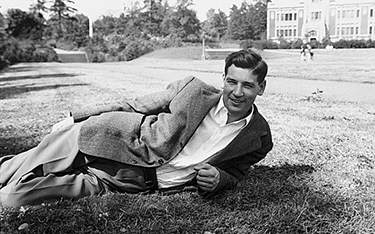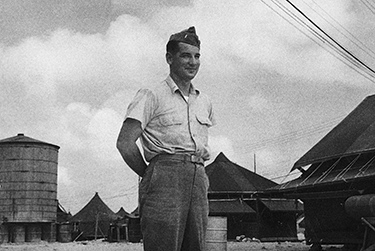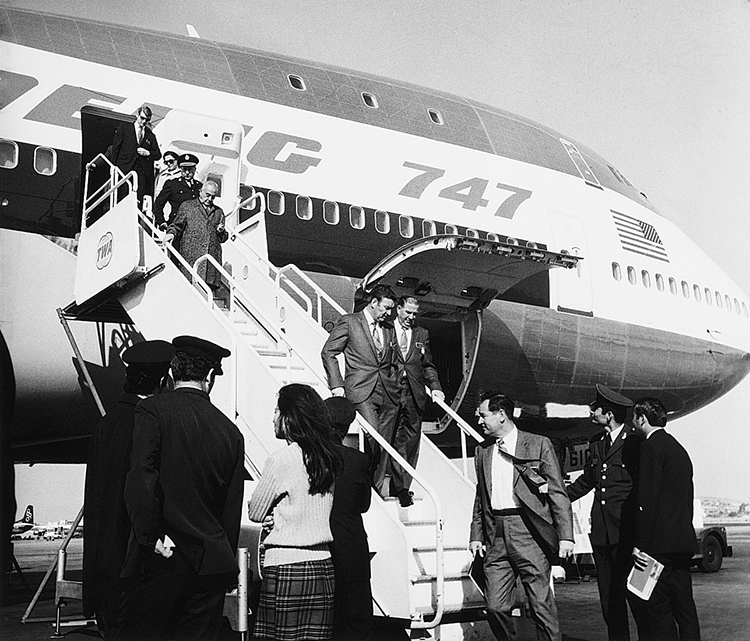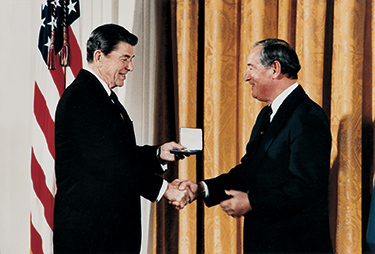He played a critical role in the development of three generations of commercial jet aircraft, helped create the nation’s transportation system and is often referred to as “the father of the 747.” He invented the concept of the “wide body” aircraft. His contributions to safe air and space travel (he served on the presidential commission that investigated the Space Shuttle Challenger explosion) are the stuff of legends.
Yet when Joseph Sutter first started working at Boeing as a just-out-of-the-Navy 24-year-old at the end of World War II, he wasn’t considered anything special.
Not that he wasn’t primed for the career he was about to embark on. A whiz at math and physics as a kid growing up on Beacon Hill, Sutter, the son of a Slovenian immigrant turned Seattle meat cutter, was an airplane nut. He always stopped to watch the planes flying out of Boeing Field as he did his afternoon Georgetown paper route and knew that one day, he would design airplanes.
But the lanky Seattle native came from very humble beginnings. Money was always tight for Sutter, his parents and three brothers. The first in his family to go to college, Sutter, a graduate of Cleveland High School, scraped together what little money he could to enroll at the University of Washington in 1939 to pursue aeronautical engineering. His dreams might have been in the clouds, but his reality meant living at home, carpooling to campus and working summers.
Later at Boeing, where he worked as an entry-level aerodynamicist for the grand total of $50 a week, some of his older, more experienced colleagues ribbed him for getting his degree from the UW. They had gone to prestigious, big-time engineering schools like MIT, Caltech and Michigan and thought anyone who went any place else—such as the UW—was just a second-class citizen.

Joe Sutter takes a break on the UW campus shortly after he graduated in the spring of 1943 with his degree in aeronautical engineering. Photo courtesy Joe Sutter.
But that never bothered Sutter. He was fulfilling his dream. And he was good at what he did.
He did such a great job with his first assignment—ironing out the problems with Boeing’s prop-driven Stratocruiser’s flight controls and clunky engines that couldn’t be cooled—that he was given prominent roles on design teams on the planes that would establish Boeing as a world leader in the embryonic field of commercial aviation—the 707, 727 and 737.
But he earned jaw-dropping, worldwide admiration when he developed the 747, which revolutionized air travel for the masses and became the world’s most recognized plane. Today, more than 1,300 of the big planes have been built, with more than 11 billion miles flown and an enviable safety record over its 31-year history. “This remarkable machine is one of the great engineering wonders of the world, like the pyramids of Egypt, the Eiffel Tower or the Panama Canal,” declares Adam Bruckner, chair of the UW Department of Aeronautics and Astronautics.
Sutter, 80, ultimately rose to executive vice president in charge of all engineering and new product development at Boeing before retiring in 1986. The honors that have come his way could fill a 747: the first American Institute of Aeronautics and Astronautics Aircraft Award for his work on the 747; the Wright Brothers Memorial Trophy; election to the National Academy of Engineering; and the U.S. Medal of Technology, presented to him by President Ronald Reagan in 1985, just to name a few.
And now the University of Washington and the UW Alumni Association have bestowed upon him their highest honor: the 2001 Alumnus Summa Laude Dignatus Award. He joins a distinguished list of alumni who have been honored as the alumnus of the year. Started in 1938, it is the highest honor the UW bestows upon its graduates.
Not too shabby for a one-time second-class citizen.

Sutter served as an aviation engineer in the Navy during the closing days of World War II at Eniwetok in the South Pacific. Photo courtesy Joe Sutter.
“I wasn’t considered too elite back when I started,” he says.
Sutter was definitely the elite of the UW aeronautical engineering program in the early ’40s, however. “He was a very bright guy who was obviously the head of his class,” recalls classmate Dale Myers, ‘43, now a retired NASA administrator. Sutter always got the best grades, except for the time Myers bested him in an advanced aeronautics class. Sutter’s reaction? “He and a few classmates threw me in Frosh Pond,” Myers says.
“He was impressive right away because he always came up with the answers to problems,” says Fred Eastman, a retired UW engineering professor who had Sutter as a student. “He hardly said a word. He did lots of studying on his own, and always came up with the right answer. Always.”
Recalls former professor Robert Hage, who had Sutter as a student in 1941-42: “Here I was, his professor fresh out of MIT, and it was all I could do to stay one to two pages ahead of him.”
Sutter always had his hands full, too. He worked summers as a mechanic in Boeing’s sub-assembly area. In addition to his college studies, he had NROTC training (for which he was paid 25 cents a day) and, among other things, he learned about celestial navigation—something that would serve him immensely during his career.
His senior year was a bittersweet, hectic time. In the span of two days in the spring of 1943, he graduated with his B.S. in aeronautical engineering (graduation was moved up because of the war), got married (he met his wife, Nancy, ‘42, while she was a home economics student) and received his orders that would send him to serve on a Navy destroyer. That last step was a letdown.
“I wanted to fly,” he says. Given his interest in aviation, and being attracted to the glamour of flying, he fired off an application for pilot training even though he was told not to. “The NROTC commander called me in and read me the riot act,” Sutter recalls. “He said we trained you to be a deck officer, and you are going to serve on the deck of a destroyer.” Guess who won.

Joe Sutter (at bottom right) was part of a mid-1970s Boeing delegation visiting Greece and other Middle Eastern countries interested in a closer look at the 747. Photo courtesy Joe Sutter.
But during the war, the Navy finally relented and sent him to aviation engineering school. He ended his military stint in the South Pacific, when he received letters from Douglas Aircraft and Boeing, which were recruiting employees. Douglas offered him $210 a month to move to Southern California. Boeing offered $200. Sutter wanted to take the money and try Southern California living, but his wife, Nancy, was about to deliver their first child. “We decided to stay in Seattle,” Sutter says. “I asked Douglas for a deferment and took the job at Boeing, thinking it would be temporary. It lasted 40 years.”
Starting on the ground floor at Boeing, Sutter actually had a glorious opportunity. The jet engine had been recently invented, and another technological innovation—the swept wing—was new. “I learned a lot in a hurry because I was involved in many projects and had little supervision,” Sutter says. “It was a time when an engineer could work on eight planes a year. Nowadays, you are lucky if you can work on one or two.”
He was the aerodynamics unit chief on the Boeing Model 367-80 (forerunner of the 707) and later the chief of technology on the 727. That set the stage for his big break in 1965—a landmark time to be in the airplane business. Air travel had boomed. The number of international passengers had climbed from 7.5 million in the mid-1950s to more than 35 million in 1965 and was predicted to surpass 100 million by 1980.
At the time, the Pentagon wanted a huge new cargo plane (the C-5A)—and it made sense that a commercial version would follow. While Boeing lost the C-5A contract to Lockheed, it nonetheless entered into the competition to build a huge passenger plane at the urging of Juan Trippe, head of Pan Am, one of the industry’s most influential power brokers. The story that has made the rounds is that Sutter, then vacationing at a remote cabin near Hood Canal in August, was tracked down by Boeing president Bill Allen and given the assignment. Actually, it was a Boeing vice president (Dick Rouzie) who reached him.

President Ronald Reagan presents Joseph Sutter with the U.S. Medal of Technology in 1985.
At first, Sutter headed up a small study group to see if building a plane that big was feasible. After some time, one of Sutter’s superiors came out of a meeting and approached the designer, who was working off napkin doodles and sketches. “Well, Sutter, you’ve got your hands full now. The boss just committed that you could build this airplane. Good luck.”
Sutter and his team (called “Sutter’s Runaways”) were off to the races. But this was no ordinary big, fun design challenge—besides having the burden of coming up with a new plane, and beating competitors to the punch, Boeing was funding the multi-million dollar project entirely with its own money. To put it bluntly, the company’s entire future was banking on Sutter.
Sutter and his design team proposed three versions, with 250, 300 and 350 seats. Pan Am and other interested airlines went for the largest version, which was going to be 2 1/2 times the size of the 707 and require four of the largest airplane engines ever made. Nothing this large had ever been attempted.
A double-decker model favored by some was quickly dismissed as an engineering nightmare. Sutter then came up with the idea of twin aisles, with three rows across of seats. The wide body jet was born. “I got a feeling it looked right,” he says.
But Sutter’s real stroke of genius was in providing the ability to carry 8 foot by 8 foot containers side by side on the main deck. By anticipating that the air freight industry would eventually adopt uniform-sized shipping containers, Sutter designed the 747 cross section to accommodate a large number of containers, stacked side by side. Thus, the 747 not only captured the passenger market but the lucrative freight market.
Partway through the design phase, it was clear Boeing faced another major hurdle: it didn’t have a plant large enough to build the 747. So it embarked on the mammoth task of clearing a forest next to Paine Field in Everett to create the world’s largest building to make the 747.
On Sept. 30, 1968—a mere 28 months after Sutter (who went from design chief to being in total control of the 747 project) first doodled out a sketch—the first 747 was rolled out of its hangar. Few had seen anything like it. Boeing proudly said you could play basketball on the wing of a 747 and that the tail was six stories tall. Everyone who gathered in Everett cheered in awe. But there were skeptics, both inside and outside of Boeing, who didn’t think a plane that big could fly. Some of Sutter’s friends even asked his wife if he knew what he was doing.
“Flying it was never a concern of mine,” Sutter says now. “The real concern was landing something this large. That was the challenge.” But it turned out to be no problem.
The first 747 flight with paying passengers occurred on Jan. 21, 1970. Pan Am’s Clipper Constitution was bound from New York to London. “The 747 will make it possible for more and more people to discover what their neighbors are like on the other side of the world,” the New York Times crowed. After an unanticipated delay, the first commercial 747 took off on its maiden flight and changed commercial flight forever.